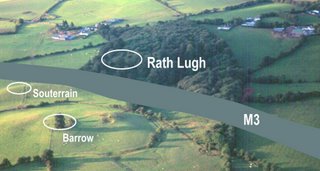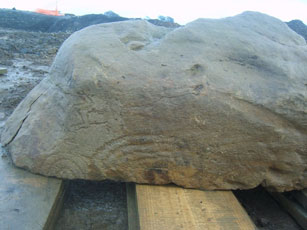PATRICK COUNIHAN October
28,2012 04:25
AM

Hill of Tara
A Dublin lecturer has discovered an unknown prehistoric site
at the Hill of Tara – without even leaving his desk!
Aidan O’Sullivan uncovered the 4,000 year old enclosure thanks
to Google Earth.
The University College Dublin lecturer was preparing a
presentation for his first year students when he noticed the
site the traditional seat of Ireland’s ancient kings.
O’Sullivan was intrigued by the unfamiliar dark, circular
feature in a field photographed by Google Earth.
The Sunday Times reports
that the lecturer was able to verify that the soil mark was a
large embanked enclosure, dating back 4,000 years.
The reports says the enclosure, between 263ft and 328ft in
diameter, is 2,000ft southwest of Rath na Riogh (Fort of
Kings) an Iron Age enclosure at the summit of the Hill of Tara
used for enthronements and other ceremonies.
The UCD lecturer believes the site was probably used for
open-air religious rituals by pagans in the late neolithic era
or Bronze Age, about 4,000 years ago.
It may also have served as a burial mound. O’Sullivan told the
paper that the enclosure’s purpose could not be confirmed
without excavating the site but few monuments on the Hill of
Tara have been excavated.
He said: “It’s certainly part of the wider landscape of the
Hill of Tara, focused on its western fringes, and is probably
also linked to some other major monuments on this side of the
hill.
“It adds to our knowledge of the sacred landscape of Tara.”
Thanks to the internet, O’Sullivan confirmed that the
enclosure had not been previously recorded on an online
database of monuments listed by the National Monuments Service
Archaeological Survey of Ireland.
He also discovered that the site was not visible on any of the
historic maps or aerial photographs provided by the Ordnance
Survey of Ireland’s website.
He also exchanged emails with fellow Irish archaeology
academics which suggested the site was a fresh discovery.
Ireland’s archaeological research institute has confirmed that
Google Earth had uncovered the monument. It retrieved an
aerial photograph it had commissioned of the area in 2008 and
adjusted the colour coverage until the site popped out of the
image.
O’Sullivan claims that this discovery is ‘indicative’ of how
digital resources such as Google Earth are transforming the
way archaeologists work.
He added: “It’s now possible to make new archaeological
discoveries just sitting in your office.
“I was able to find the site, check that it was previously
unknown and then work quickly with colleagues to get further
evidence for it, and do all of that online. To an extent, that
would have been inconceivable 10 years ago.
“Every year we are getting more and better digital information
online, from Ordnance Survey Ireland, the records of the
National Monuments Service, Bing, Google Earth. And that’s all
without going out to do fieldwork.”
Aerial and satellite imaging is also leading to an increase in
citizen science, O’Sullivan believes.
He said: “Just as amateur astronomers use telescopes in back
gardens to identify distant galactic objects and then contact
professional astronomers to get confirmation, so too could
amateur archaeologists.
“With ordinary people working with institutes, universities
like UCD, or museums, the prospect for archaeological
discoveries is great.”
The Hill of Tara is the birthplace of Halloween as the site
where the Celts celebrated Samhain, the pagan festival that
marked the end of the old Celtic year and the beginning of the
new.
![]()
![]()
![]()
![]()
![]()
![]()
![]()
![]()
![]()
![]()
![]()
![]()
![]()

![]()
![]()
![]()








